|
|
|
Sort Order |
|
|
|
Items / Page
|
|
|
|
|
|
|
| Srl | Item |
| 1 |
ID:
137252
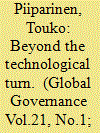

|
|
|
|
|
| Summary/Abstract |
In 2013 the United Nations applied two new peacekeeping instruments, the Intervention Brigade and unmanned aerial vehicles, in the Democratic Republic of Congo. This article argues that the significance and novelty of the Brigade and UAVs for UN peacekeeping are not only attributable to their technologically advanced and robust capacities, as maintained in previous accounts. Most importantly, these instruments also function as the harbingers of a new paradigm for peacekeeping—sovereignty building. The current technological turn of UN peacekeeping is only an epiphenomenon of a more profound paradigm shift in UN peacekeeping toward sovereignty building. Sovereignty building can be defined as an emerging set of peacekeeping practices that aims to create or reinforce four constitutive elements of sovereignty, which have previously been sidelined in state building; namely, sovereign agency (the political will of the host government), sovereign space (the area of supreme state authority), related sovereignty (the sovereignty network of subregional and regional peers), and popular sovereignty (the protection of the population).
|
|
|
|
|
|
|
|
|
|
|
|
|
|
|
|
| 2 |
ID:
137212
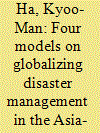

|
|
|
|
|
| Summary/Abstract |
This study contributes to disaster management in the Asia-Pacific region by examining four models: the United Nations/International Strategy for Disaster Reduction (UN/ISDR) professional coordination, US surveillance-oriented management, Korean copy-oriented efforts, and Indonesian homogenization-based action. Based on the comparative perspective, as well as basic concepts on global disaster management, the study cross-checks two features of global disaster management, namely, political interests and dynamic culture, and three comparative variables, namely, stakeholders, resources, and strategies, in each model. The biggest contribution of the study is that it more rigorously examines the comparative analytical framework of the four models. The key tenet is that the above-mentioned models have to address the continuous study of local culture and the job security of employees (UN/ISDR model), more partnership with private institutions and feasible training (US model), long-term international study and creative strategies (Korean model), and gender-sensitive management and information exchange (Indonesian model), by further utilizing both global education and networks.
|
|
|
|
|
|
|
|
|
|
|
|
|
|
|
|
| 3 |
ID:
139299
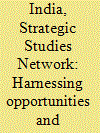

|
|
|
|
|
| Summary/Abstract |
Based on the work of the Maritime Security Working Group within the Strategic Studies Network (SSN), this report provides both diagnosis and prescriptions regarding security threats in the Indian Ocean Region (IOR). The IOR, a large maritime area that extends from coastal Africa through the Middle East and South Asia and on to Australia, is a major conduit for global trade, a littoral zone of developing powers, and the focus of a series of rising security challenges. Thus, not only is the security of the IOR of major importance for IOR littoral states, it is also of vital importance for much of landlocked Africa and Asia, along with major economic powers like China, the European Union and the United States.
This collaborative report highlights two overarching themes, the first being that the IOR, while of great importance to regional/global stability, needs to be conceived of as a key strategic zone. In short, security issues in the IOR must be addressed with a sense of urgency. The second theme is that this diverse region suffers from a lack of institutions capable of bridging gaps and easing tensions. The institutions that do exist are either ineffective or are of a very specific nature. Greater attention must be directed towards building shared perspectives on security issues, particularly as they relate to non-state or non-traditional threats.
This report reflects the desire of all participating experts in this Working Group to see comprehensive strategic assessments being developed within the global foreign policy community. Thus, this report is the start of strategic dialogues that hopefully will commence among IOR littoral states. The IOR is an essential conduit that draws in Europe, North America and the Asia-Pacific. It is too often conceived within the limitations of a sub-region (like South Asia, Eastern Africa or the Gulf). The IOR is full of threats, but it also offers attractive opportunities for enhancing global security. While the IOR’s littoral zones are often divided along national boundaries, the IOR is a huge maritime domain, where no single country can guarantee stability and where a maritime context may offer unique chances to bypass barriers inhibiting cooperation on land. The opportunity for enhancing security is there and it is hoped that this analysis can assist in the formation of policies that help all actors and nations.
|
|
|
|
|
|
|
|
|
|
|
|
|
|
|
|
| 4 |
ID:
137787


|
|
|
|
|
| Summary/Abstract |
One of the goals of peacekeeping operations is limiting the amount of violence that takes place during a civil war. However, peacekeeping forces cannot occupy every part of a country that is engulfed in a civil conflict. This raises the question as to where peacekeeping forces decide to go once they are deployed to a civil war-torn country. In this article, we contribute to the burgeoning research that examines peacekeeping at the microlevel by attempting to determine whether peacekeeping operations go to those areas that are in most need of their help. Utilizing geocoded data from the UCDP GED and PKOLED projects, we use spatial analysis techniques to create kernel density estimates of civil war violence and peacekeeping operations at site-specific locations. We then use these newly generated variables in a variety of regression models to determine whether the location of civil war battles influences the location of peacekeepers. The analysis confirms our expectations in that the location of violence significantly predicts the location of peacekeeping operations, but only after these operations have been in a civil war-torn country for a considerable length of time. Contrary to our expectations, however, peacekeeping operations do not seem more adept at identifying and responding to government and rebel violence relative to attacks against civilians
|
|
|
|
|
|
|
|
|
|
|
|
|
|
|
|
| 5 |
ID:
137155
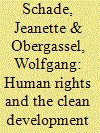

|
|
|
|
|
| Summary/Abstract |
The 2010 UN climate conference in Cancún emphasized that ‘Parties should, in all climate change related actions, fully respect human rights’. However, so far there is no further guidance. This article discusses the relevant legal human rights norms and two case studies from the Kyoto Protocol's Clean Development Mechanism (CDM). The first case (Bajo Aguán, Honduras) shows that the current absence of any international safeguards can lead to registration of highly problematic projects. The second case (Olkaria, Kenya) suggests that safeguards, introduced here as a side effect of World Bank involvement, can have a positive impact, but that it is necessary to have them based on human rights. It therefore seems recommendable that the UN climate regime develop mandatory human rights safeguards. In addition or alternatively, individual buyer countries or groups of countries, such as the European Union, could introduce their own additional requirements for CDM projects
|
|
|
|
|
|
|
|
|
|
|
|
|
|
|
|
| 6 |
ID:
139217
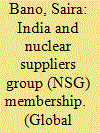

|
|
|
|
|
| Summary/Abstract |
The Nuclear Suppliers Group (NSG) was founded in 1974 in response to the Indian nuclear test in order to prevent nuclear proliferation by controlling nuclear exports. In 2008, the NSG exempted India from its full-scope safeguards (FSS) condition, making it the first country to be allowed to have nuclear trade with NSG members while retaining its nuclear weapons program. India won this waiver after tough negotiations and having resisted tough nonproliferation conditions. India is now bidding for NSG membership. This paper analyses the prospects for the membership in light of the waiver negotiations and how the waiver negotiations can guide us in assessing the likely path of the membership negotiations. This study concludes that India will resist any conditions and the US and India have to invest massive diplomatic efforts to reach a formula that addresses the nonproliferation concerns of member states.
|
|
|
|
|
|
|
|
|
|
|
|
|
|
|
|
| 7 |
ID:
137156
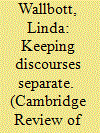

|
|
|
|
|
| Summary/Abstract |
The Alliance of Small Island States (AOSIS) encompasses more than 40 low-lying and island developing states that are among the most vulnerable but also most vocal parties in international climate negotiations. Over the years AOSIS's strategies comprised of the building of scientific expertise, and leadership by example, but also a particular framing that puts emphasis on multilateral processes to deal with issues of common concern and established principles of the international community. The initial assumption of the paper is that a frame alignment of climate change and human rights concerns would strengthen the coalition's moral and legal arguments. However, as a frame analysis of close to 50 coalition submissions and statements reveals, such a linkage is not established. The paper concludes by outlining three possible explanatory factors for this observation: the nature of the issue area, the character of the coalition and the professional background of AOSIS negotiators.
|
|
|
|
|
|
|
|
|
|
|
|
|
|
|
|
| 8 |
ID:
137553
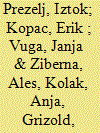

|
|
|
|
|
| Summary/Abstract |
The military transformation process typically focuses on the structural, operational, technical, personnel, training, and similar dimensions. Yet conceptual and practical approaches to such transformation have largely neglected the importance of the perceptional and subjective aspects that have frequently negatively affected this process. This article fills this gap by developing the Input-Process-Output Transformation Model and testing it on a sample of 55 military transformation experts from 23 NATO and PfP countries. The results highlight what are perceived to be the most important variables affecting the transformation input, process, and output that need to be incorporated in future integrated transformation strategies. It also turns out that transformation strategies need to increase the involvement of civil society, improve public support, the level of internal understanding of transformation goals, and the level of experimentation.
|
|
|
|
|
|
|
|
|
|
|
|
|
|
|
|
| 9 |
ID:
137554
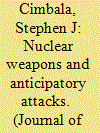

|
|
|
|
|
| Summary/Abstract |
Anticipatory attacks come in two forms. Preemptive attacks are first strikes based on the assumption that the opponent has already set an attack in motion or is about to, and the purpose of the preemption is to mitigate or neutralize the effect of the enemy’s move. Preventive wars, on the other hand, are undertaken to preclude a threatening power from increasing its capabilities relative to ours, assuming that smaller differences in power will lead the challenger to become more risk acceptant. With respect to nuclear weapons, deterrence is intended to preclude both preemptive and preventive attacks, although the former is judged to be more likely than the latter. Leaders authorizing a nuclear preemption would need to have high confidence about the intentions as well as the capabilities of the other state, and the requirements for fine-grained intelligence would be considerable, prior to any actual launch of delivery systems. Seeing into the other side’s world view, regardless of its apparent rationality or lack thereof, would also be prudent before undertaking a decision of such magnitude.
|
|
|
|
|
|
|
|
|
|
|
|
|
|
|
|
| 10 |
ID:
137788


|
|
|
|
|
| Summary/Abstract |
A rich literature has developed focusing on the efficacy of peacekeeping operations (PKOs) in a temporal sense—asking whether the periods following a deployment are more peaceful or not. We know less about the efficacy of PKOs in a spatial sense. Can peacekeeping shape the geographic dispersion of particular episodes of violence? We posit that PKOs can contain conflict by decreasing the tactical advantage of mobility for the rebels, by obstructing the movement of armed actors, and by altering the ability for governments to seek and confront rebel actors. We investigate the observable implications using georeferenced conflict polygons from the Uppsala Conflict Data Program's (UCDP) Georeferenced Event Dataset (GED). Our findings confirm that PKOs tend to decrease movement in the conflict polygons, especially when robust forces are deployed and when rebel groups have strong ethnic ties. Our findings, on the one hand, imply that PKOs reduce the geographic scope of violence. On the other hand, PKOs may allow nonstate actors to gain strength and legitimacy and thus constitute an even greater future threat to the state whether some form of accord is not reached.
|
|
|
|
|
|
|
|
|
|
|
|
|
|
|
|
| 11 |
ID:
137186
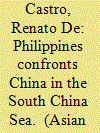

|
|
|
|
|
| Summary/Abstract |
Using the Scarborough Shoal standoff between China and the Philippines as a case study, in this article I examine two approaches to addressing territorial disputes—power politics and liberalismlegalism. China, a major power, uses realpolitik to press its expansive claim in the South China Sea. The Philippines, a small power, adopts the liberal-legal approach that seeks to balance against China. During the standoff, China drove the Philippines out of the shoal, though stopping short of an armed clash, and effected a de facto occupation of the contested area. As a countermeasure, the Philippines filed a statement of claim with the International Tribunal for the Law of the Sea. The confrontation was a test of Thucydides's age-old aphorism that “the strong do what they have the power to do, and the weak accept what they have to accept.”
|
|
|
|
|
|
|
|
|
|
|
|
|
|
|
|
| 12 |
ID:
137742
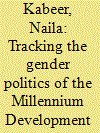

|
|
|
|
|
| Summary/Abstract |
This article tracks the gender politics of the processes that led to the adoption of the Millennium Development Goals and that continued to feature in subsequent policy debates. It suggests that this politics is rooted in tensions between conceptualisations of rights and capabilities that characterised the preceding decade. While feminist organisations made major gains on women’s rights during 1990s, it was a narrow version of human capabilities that defined the MDGs. Feminist efforts since then have focused on defending sexual and reproductive rights in the face of the attacks mounted by an ‘unholy alliance’ led by the Vatican and supported by a shifting group of countries and religious groups. This has led to the relative neglect of the economic injustices associated with the dominant market-led model of development.
|
|
|
|
|
|
|
|
|
|
|
|
|
|
|
|
|
|
|
|
|